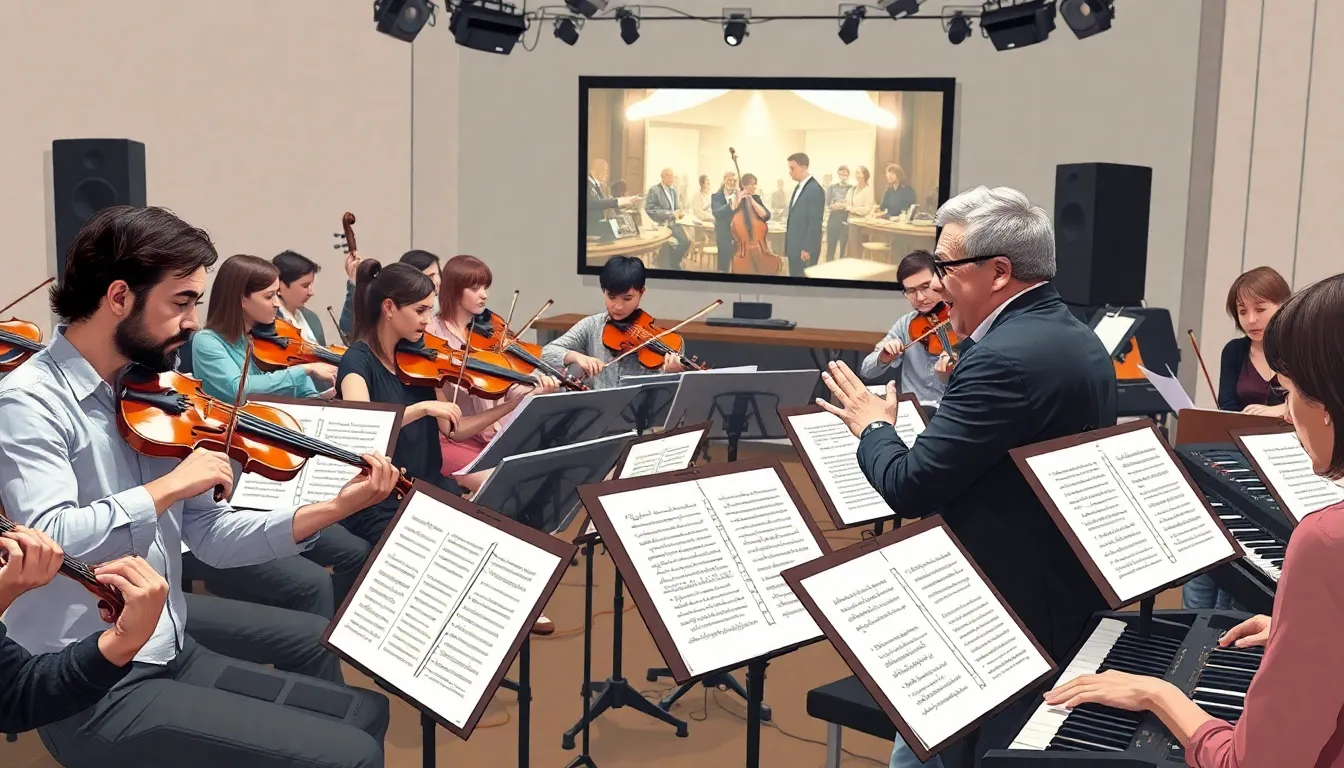Table of Contents
ToggleImagine watching a heart-stopping chase scene in a movie without the exhilarating music that makes your heart race. It’s like eating popcorn without butter—sure, it’s still popcorn, but where’s the excitement? Film scores play a crucial role in shaping the emotional landscape of a film, guiding viewers through laughter, tears, and everything in between.
These musical masterpieces are more than just background noise; they’re the unsung heroes that elevate storytelling to new heights. From the haunting melodies that linger in your mind to the triumphant crescendos that make you want to fist pump, film scores have a unique power to transform a simple scene into an unforgettable experience. Dive into the world of film scores and discover why they’re the secret ingredient that keeps audiences coming back for more.
Understanding Film Score Significance
Film scores play an essential role in shaping the audience’s emotional experience. Music creates an atmosphere that enhances storytelling, enriching scenes with depth and nuance. Composers carefully craft scores to evoke specific feelings, transforming ordinary moments into unforgettable experiences.
A musical score provides context and mood, guiding viewers’ reactions to characters and events. For instance, a tense score heightens suspense during a thrilling chase scene, while a gentle melody might accompany a heartfelt moment between characters. This strategic use of music leads audiences to feel joy, sadness, or fear.
Scores also serve as motifs, linking characters or themes throughout a film. By integrating recurring melodies, composers establish connections, reinforcing character development and narrative arcs. An audience may feel a sense of familiarity or anticipation when hearing a particular theme associated with a character’s journey.
Notably, film scores can transcend on-screen narratives, finding a place in popular culture. Iconic scores become synonymous with the films they represent, often invoked in various media or settings. Their power lies in their ability to evoke memories tied to specific moments within the film.
The significance of a film score extends beyond mere background music. The emotional resonance created by these compositions drives viewer engagement. Without a compelling score, films may lack the emotional impact that resonates with audiences, underscoring the importance of film scores in cinematic storytelling.
The Role of Music in Film

Music plays a crucial role in film by shaping emotional experiences and enhancing storytelling. It guides audience reactions and reinforces connections with characters and scenes.
Emotional Engagement
Film scores have a unique ability to evoke powerful emotions. They can turn an ordinary moment into a gripping one, making viewers feel joy, sadness, or tension. For instance, a haunting melody might resonate during a character’s sorrowful scene. Audiences often find themselves immersed in the narrative due to these emotional cues. Composers use specific instruments and harmonies to tap into feelings, creating an atmosphere that draws viewers in. Emotional engagement is essential; it fosters a deeper connection between the audience and the film.
Storytelling Enhancement
Music significantly enhances storytelling by providing context and depth. Audiences can understand character motivations and plot developments through strategic score placements. A swift orchestral surge can signal impending danger, while a soft piano piece reveals intimacy. Furthermore, motifs can link themes and characters, making narratives more cohesive. Iconic themes often become synonymous with characters, adding layers to the story. By weaving music into the fabric of the film, scores elevate storytelling, offering viewers a richer experience.
Historical Context of Film Scores
Film scores have evolved significantly since the inception of cinema, playing a crucial role in narrative development and audience engagement. Early silent films relied on live musicians to create atmosphere, yet the advent of synchronized sound in the late 1920s transformed the landscape of film music.
Evolution of Film Music
Silent films featured live orchestras, providing a musical backdrop to visual storytelling. With the introduction of synchronized sound in films like The Jazz Singer (1927), composers began creating original scores tailored to enhance narrative depth. The 1930s and 1940s saw the rise of lush orchestral arrangements, as prominent studios employed full orchestras to evoke strong emotions. By the 1950s and 1960s, experimentation with electronic music and jazz inspired innovative compositions. The late 20th century marked a return to minimalism, with composers focusing on subtlety and emotion, ultimately influencing modern film music.
Key Composers and Their Contributions
Multiple influential composers reshaped the film score landscape, each leaving a unique mark. John Williams, known for his iconic scores in films like Star Wars and Indiana Jones, employed grand orchestration and memorable motifs that resonate with audiences. Ennio Morricone, particularly famous for The Good, the Bad and the Ugly, introduced innovative soundscapes, blending diverse genres. Hans Zimmer revolutionized film music with his use of electronic elements in scores like Inception and The Dark Knight. Other noteworthy figures include Bernard Herrmann, whose work in Psycho exemplified the power of music to enhance tension, and Danny Elfman, known for his collaborations with Tim Burton. These composers collectively defined film music, elevating it to an essential storytelling tool.
Elements of a Film Score
Film scores consist of various components that work together to enhance cinematic storytelling.
Melodic Structure
Melodic structure shapes how music interacts with the film’s narrative. A strong melody captures attention and evokes emotions. Composers often use motifs, short melodic phrases, to represent characters or themes. For instance, the iconic “Imperial March” denotes Darth Vader’s presence in “Star Wars.” Different melodic lines create suspense or joy, guiding audience feelings throughout the film. Themes can also evolve, reflecting character development and narrative progress. Heightened tension through dissonance or bittersweet melodies can leave a lasting impression. Overall, melodic structure serves as the backbone, weaving emotional responses into the film’s fabric.
Instrumentation and Orchestration
Instrumentation and orchestration define the overall texture and mood of the score. Various instruments contribute unique tonal qualities. Strings might convey warmth, while brass can evoke power. Percussion adds rhythmic energy and intensity, creating a dynamic listening experience. Composers select instruments based on the film’s genre and emotional requirements. Moreover, orchestration decisions affect how themes are presented. Using a full orchestra can create a lush soundscape, while smaller ensembles might deliver intimacy. Strategic layering of instruments enhances specific scenes, fostering deeper engagement. Ultimately, instrumentation and orchestration unite to enrich the film’s emotional landscape.
The Impact of Film Scores on Audience Perception
Film scores profoundly influence audience perception by setting the emotional tone throughout the narrative. Audiences often respond instinctively to music, which shapes their feelings toward characters and events. A suspenseful score may cause viewers to feel anxious, while a romantic melody can evoke warmth and tenderness.
Scores provide context, enriching scenes with emotional depth. For instance, a dramatic crescendo can amplify tension during critical moments, guiding the audience’s responses. Listeners connect specific themes to characters, allowing them to anticipate emotions based on familiar motifs.
Composers use a variety of instruments to evoke distinct feelings. Strings may deliver melancholy, while brass instruments often convey triumph. This deliberate selection enhances the film’s atmosphere, immersing viewers in the story.
Cultural references also play a significant role. Iconic film scores transcend their original contexts, becoming synonymous with particular scenes or emotions. Audience members often recall specific moments associated with recognizable pieces, reinforcing the music’s power.
The connection between score and narrative remains crucial. Music often serves as a narrative device, illustrating character arcs and plot developments. Themes may evolve alongside characters, mirroring their journeys and emotional growth.
Overall, film scores significantly shape how audiences perceive stories. Composers craft these musical landscapes intentionally, guiding emotional responses and enriching the cinematic experience. Through strategic placements and thematic consistency, scores deepen connections between the audience and the film.
Film scores are more than just background music; they’re integral to the storytelling process. By crafting emotional landscapes and enhancing character development, composers create a profound connection between the audience and the film. This connection transforms viewing into an immersive experience, allowing audiences to feel the highs and lows alongside the characters.
As film music continues to evolve, its significance remains undeniable. Iconic scores not only define individual films but also become part of cultural memory. The artistry behind film scores enriches the cinematic experience, ensuring that music will always play a vital role in how stories are told on screen.




